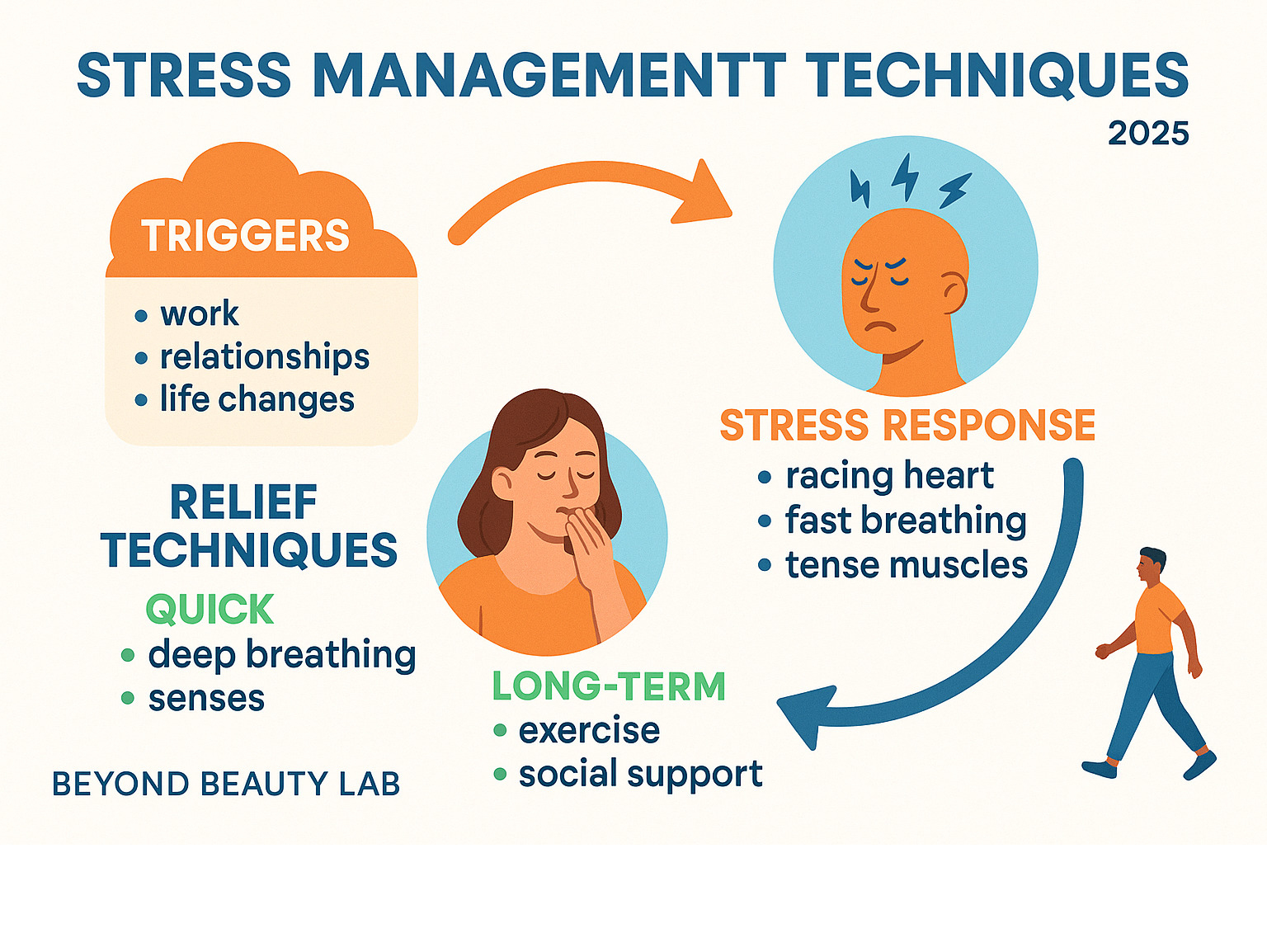Why Stress Management Techniques Are Essential for Modern Life
Stress management techniques are proven methods to reduce the impact of daily pressures. While stress is a widespread issue, the good news is that you have more control than you might think. You can use quick-relief methods for immediate calm or build long-term strategies for lasting resilience.
Quick stress relief methods include:
- Deep breathing exercises (4-7-8 technique, box breathing)
- Grounding techniques (5-4-3-2-1 sensory method)
- Progressive muscle relaxation
- Mindful movement (stretching, short walks)
Long-term stress management strategies involve:
- The 4 A’s: Avoid, Alter, Adapt, Accept
- Regular exercise and rhythmic movement
- Healthy sleep habits and balanced nutrition
- Social connections and boundary setting
From traffic jams to major life changes, stress floods your body with hormones like cortisol and adrenaline, triggering your heart to pound and muscles to tense. Research shows that practicing these techniques for even a few minutes daily can build a reserve of inner calm. The fastest way to reduce stress is by taking a deep breath and engaging your senses. This activates your body’s natural relaxation response, bringing your mind and body back into balance.
As one stress management expert puts it: “The act of taking control is in itself empowering, and it’s a crucial part of finding a solution that satisfies you.”

Explore more about Stress management techniques:
Understanding Your Stress: Causes and Symptoms
Stress comes from both negative and positive events, like a dream promotion or planning a wedding. Common causes include work pressure from deadlines, financial worries about bills or job security, and relationship issues with family or friends. Even major life changes like moving or daily hassles like traffic can stack up, creating a constant hum of stress.
Your body signals when stress is overwhelming. Physical symptoms include headaches, muscle tension (especially in the neck and shoulders), fatigue, and changes in appetite. Emotional symptoms can be just as telling, such as irritability, anxiety, or difficulty focusing. Many people reach for unhealthy coping mechanisms like alcohol, binge-eating, or excessive screen time, which provide temporary relief but worsen stress long-term. Recognizing these patterns is the first step toward adopting healthy coping mechanisms and effective stress management techniques.
How Your Body Responds to Stress
Your body’s stress response, or fight-or-flight response, is an ancient survival mechanism. It unfolds in three stages. The alarm stage is the initial panic, where your brain releases adrenaline and cortisol, causing your heart to pound and muscles to tense. In the resistance stage, your body tries to adapt and recover from the initial stress. If stress continues, you enter the exhaustion stage, where your energy reserves are depleted. This chronic stress can lead to serious long-term consequences like heart disease, a weakened immune system, and mental health issues like anxiety and depression.
Identifying Your Personal Stress Triggers
What stresses you out is unique. A stress journal can help you become a detective of your own stress patterns. For a week or two, note what triggers your tension, how you feel physically and emotionally, and how you cope. This habit tracking can reveal patterns, like feeling most stressed on Sunday evenings or after scrolling social media. By recognizing patterns, you can differentiate between external stressors (events around you) and internal stressors (your thoughts and reactions). Understanding your personal triggers is the first step to regaining control and choosing responses that help, not hurt.
Quick-Relief: Strategies for Immediate Calm
When stress hits hard and fast, you need tools that work in minutes. These emergency stress management techniques can be used anywhere to activate your body’s natural relaxation response, stopping stress before it spirals.
The Power of Breath: Simple Breathing Exercises
Your breath is your most powerful tool for instant stress relief. By consciously slowing your breathing, you can calm the nervous system and increase oxygen flow to the brain.

- Belly breathing: Place one hand on your stomach. As you inhale slowly through your nose, feel your belly rise. This deep, diaphragmatic breathing signals your brain to relax.
- The 4-7-8 technique: Exhale completely, then inhale through your nose for four counts. Hold for seven, then exhale through your mouth for eight. Repeat a few times for a tranquilizing effect.
- Box breathing: Inhale for four counts, hold for four, exhale for four, and hold for four. This rhythm gives your racing mind something to focus on.
Ground Yourself with Your Senses
Grounding techniques pull you back to the present moment through sensory engagement. They shift your focus from internal worries to external reality.
- The 5-4-3-2-1 method: Name five things you see, four you hear, three you can touch, two you can smell, and one you can taste. This simple exercise anchors you in the here and now.
- Aromatherapy: Scents like lavender or chamomile have a direct connection to your brain’s emotional center and can lower stress hormones.
- Physical touch: Hugging a loved one releases oxytocin, the “cuddle hormone,” which lowers stress. Holding a warm mug or petting an animal works too.
- Mindful observation: Simply watching clouds or truly listening to a song can break the cycle of stressful thoughts.
Release Tension with Mindful Movement
Stress often manifests as physical tension. Mindful movement releases this tension while shifting focus from mind to body.
- Progressive muscle relaxation: Tense a muscle group (like your fists) for five seconds, then release completely. Work your way through your body to feel the difference between tension and relaxation.
- Stretching at your desk: Simple neck rolls, shoulder shrugs, or reaching for the ceiling can release the physical grip of stress.
- Taking a short walk: This combines movement, a change of scenery, and feel-good endorphins to reset your mind.
Mastering Long-Term Stress Management Techniques: The 4 A’s
While quick fixes are helpful, building true resilience requires proactive habits. Effective stress management techniques should be part of your daily routine, strengthening your foundation over time. The 4 A’s of stress relief – Avoid, Alter, Adapt, and Accept – provide a practical framework for getting ahead of stress.

Avoid: Eliminate Unnecessary Stressors
Not all stress is mandatory. Sometimes, the smartest strategy is to remove the stressor. This means learning to say no to commitments that overwhelm you and setting boundaries to protect your time and energy, like turning off work notifications after hours. Managing your environment by avoiding triggers, like the morning news if it causes anxiety, and paring down your to-do list to essentials can significantly reduce your stress load.
Alter: Change the Situation
When you can’t avoid a stressor, try to change it. Use assertive communication to express your needs clearly and respectfully, rather than bottling up feelings. Good time management can also give you a sense of control; techniques like breaking large projects into smaller steps make them feel less daunting. Be willing to compromise and focus on creating a balanced schedule that includes work, rest, and fun.
Adapt: Adjust Your Perspective
Often, you can’t change the situation, but you can change how you view it. Reframing negative thoughts is a powerful tool. Instead of thinking, “I can’t handle this,” try, “This is a challenge, but I can get through it.” Practice positive self-talk and gratitude by noticing a few good things each day. It’s also important to adjust your standards and let go of perfectionism – sometimes “good enough” is the healthiest option. Seeing the bigger picture helps put daily hassles into perspective.
Accept: Let Go of What You Can’t Control
Accepting what you cannot change is one of the most freeing strategies. Instead of fighting reality, focus on what you can control, like your own actions and responses. Practice forgiveness, both for others and yourself, to release resentment. Sharing your feelings with trusted friends or family can lighten your emotional burden and provide new perspectives. Finally, try looking for the upside or learning opportunities in difficult situations, as challenges often lead to growth.
Building a Resilient Lifestyle
Effective stress management techniques become part of your daily life, building resilience like a muscle. This isn’t about adding more pressure, but creating a lifestyle that naturally supports your well-being and equips you to handle challenges with strength.
Mindful Movement: Physical Stress Management Techniques
Moving your body is one of the fastest ways to shift your mental state. Physical activity breaks the cycle of muscle tension and repetitive thoughts by releasing endorphins, your body’s natural mood elevators. Rhythmic exercises like walking, swimming, or dancing are particularly calming, as the repetitive motion has a meditative quality. You don’t need to run a marathon; even simple movements like taking the stairs or gentle stretching can improve your mood and sleep quality.

Nourishment and Rest for a Calm Mind
What you eat and how you sleep directly impact your ability to handle stress. A balanced diet with complex carbohydrates, lean proteins, and healthy fats provides steady energy and resilience. Foods rich in antioxidants, Vitamin C, and Magnesium are particularly helpful. Be mindful that caffeine can amplify anxiety and sugary foods can lead to energy crashes. Sleep is crucial for stress recovery, so aim for 7 to 9 hours per night. A relaxing bedtime routine, like a warm bath or reading, signals to your body that it’s time to wind down.
The Role of Social Connection and Joy
Humans are wired for connection, and a strong support system is a powerful buffer against stress. Face-to-face interaction with friends and family can trigger hormones that calm your nervous system. It’s also vital to cultivate joy and meaning in your daily life. Hobbies and creative pursuits offer an escape and a sense of purpose. Don’t underestimate the power of laughter, which provides immediate relief and boosts your immune system. Finally, helping others can reduce your own stress by fostering a sense of connection and purpose.
Frequently Asked Questions about Stress Management
When should I seek professional help for stress?
Recognizing when you need extra support is a sign of strength. Consider seeking professional help from a therapist or doctor if your stress:
- Feels overwhelming or chronic and doesn’t improve with self-care.
- Causes significant impairment in your work, relationships, or daily life.
- Leads to worsening symptoms or unhealthy coping mechanisms like substance use or social withdrawal.
- Is accompanied by persistent anxiety or depression.
A professional can offer specialized strategies like Cognitive Behavioral Therapy (CBT) or discuss other treatment options. Seeking help is a proactive step toward feeling better.
What is the fastest way to relieve stress?
The fastest way to relieve stress is to activate your body’s built-in relaxation response. Combine deep breathing (like the 4-7-8 technique) with sensory grounding (like the 5-4-3-2-1 method). These techniques pull your mind out of a stressful spiral and anchor you in the present. Soothing movement, such as a quick stretch or a short walk, can also provide immediate relief by releasing physical tension. These simple methods work within minutes to bring your mind and body back into balance.
Can stress ever be a good thing?
Yes, not all stress is bad. “Eustress” is a positive form of stress that can be beneficial. Think of the focused energy before a big presentation or the excitement of a new challenge. This type of stress can motivate us, increase focus, and improve performance. When a stressor is manageable and seen as a challenge rather than a threat, it encourages growth and builds resilience. The key difference between helpful eustress and harmful distress is often our perception and the duration of the stress.
Conclusion
With this toolkit of stress management techniques, you can now tackle stress from every angle, from sudden panic to chronic overwhelm. It’s not stress itself but your response to it that matters. By understanding your triggers, you’ve already taken the first step toward control.
Your quick-relief arsenal, including deep breathing and grounding, offers immediate calm. For long-term resilience, the 4 A’s framework (Avoid, Alter, Adapt, Accept) empowers you to proactively manage life’s challenges. Building a resilient lifestyle through mindful movement, good nutrition, rest, and social connection creates a strong foundation that stress can’t easily shake.
Consistency is more important than perfection. Even a few minutes of practice each day builds a reserve of inner calm. Your personal stress management plan will be unique to you, so experiment to find what works best.
At Beyond Beauty Lab, we believe true radiance comes from inner balance. Managing stress isn’t just about feeling better – it’s about creating space for joy, creativity, and authentic beauty to flourish. The power to transform your relationship with stress is in your hands.







